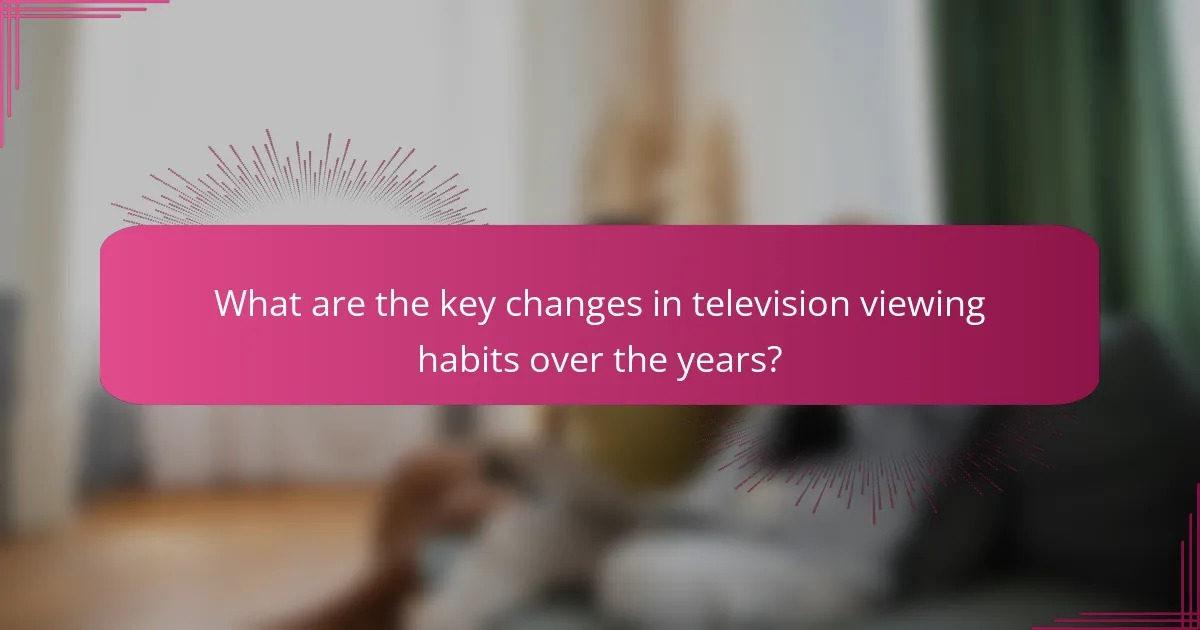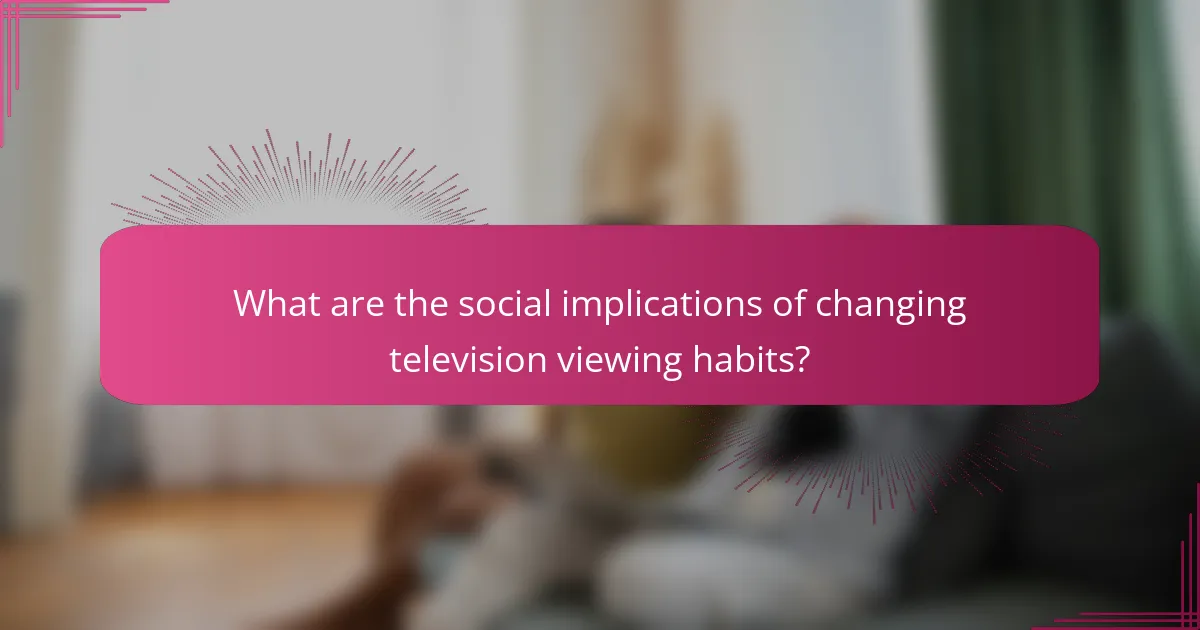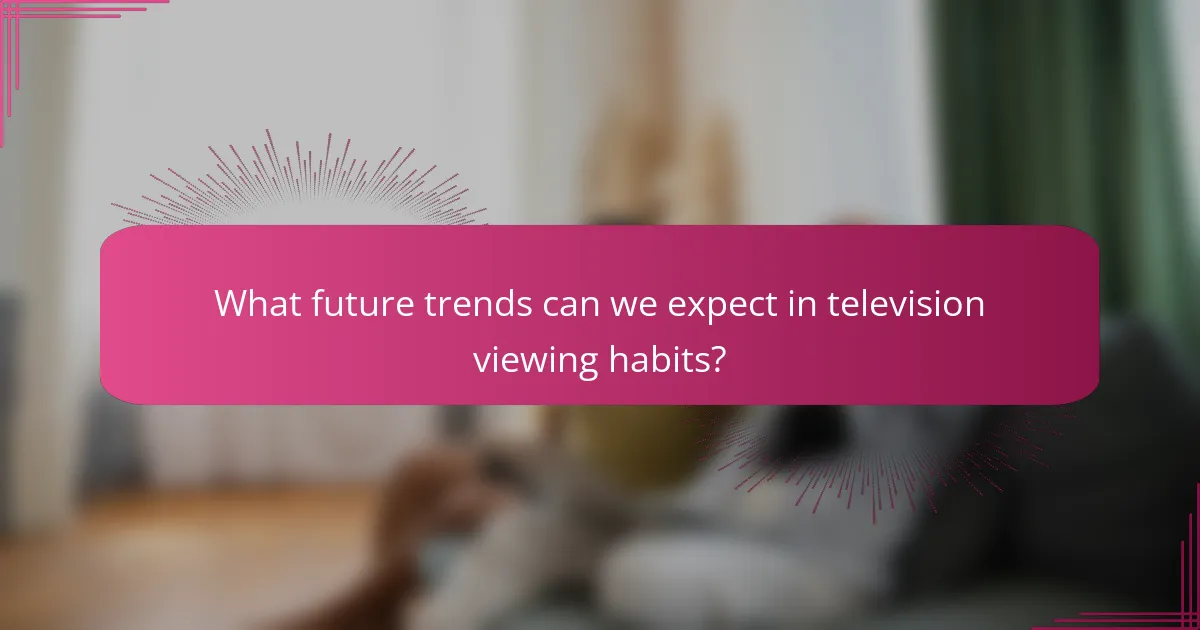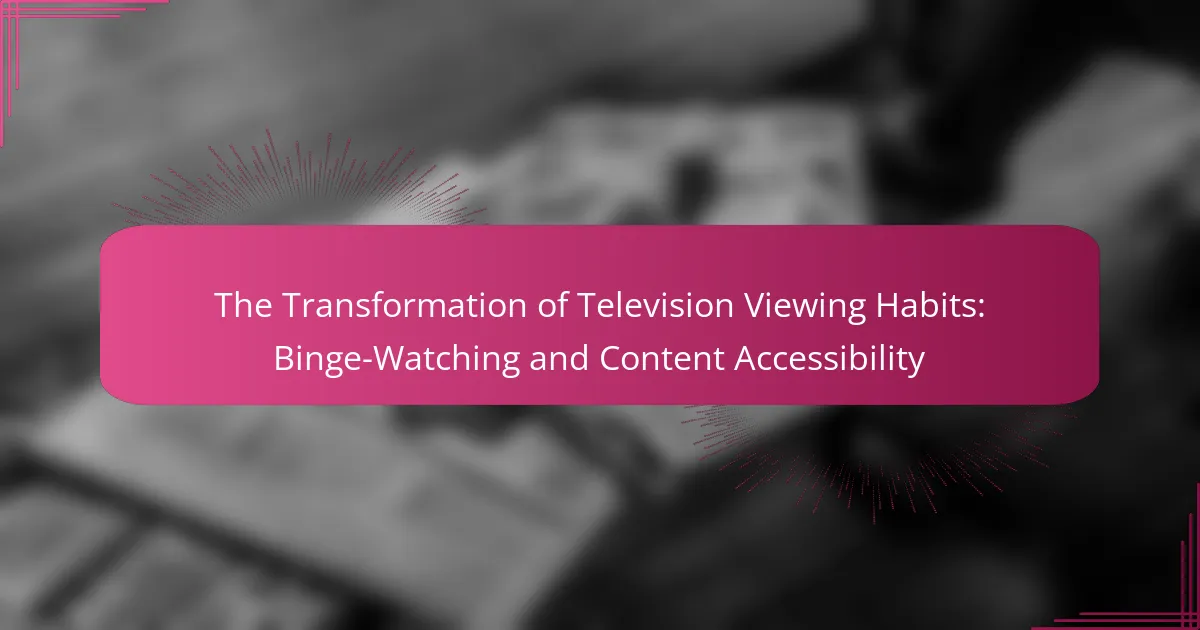Television viewing habits have undergone significant transformations due to technological advancements and changing consumer preferences. The rise of cable television in the 1980s and streaming services in the 2000s has expanded content accessibility, leading to a preference for binge-watching entire seasons rather than waiting for weekly episodes. This shift has implications for social interactions, family dynamics, and cultural consumption, as viewers increasingly engage with diverse narratives and experience changes in attention spans. Data indicates a decline in traditional TV viewership, with over 80% of U.S. households now subscribing to at least one streaming service. Future trends suggest a continued movement towards personalized viewing experiences and interactive content.

What are the key changes in television viewing habits over the years?
Television viewing habits have shifted significantly over the years. The introduction of cable television in the 1980s expanded channel options. Streaming services emerged in the 2000s, allowing on-demand access to content. Binge-watching became popular with the rise of platforms like Netflix. Viewers now prefer watching entire seasons at once rather than waiting for weekly episodes. Mobile devices have also changed how and where people watch TV. Social media influences viewing choices and creates shared experiences. Data shows that traditional TV viewership has declined in favor of streaming. Younger audiences increasingly favor digital platforms over cable subscriptions.
How has technology influenced television viewing habits?
Technology has significantly influenced television viewing habits by enabling on-demand content access. Streaming services like Netflix and Hulu allow viewers to watch shows at their convenience. This shift has led to the rise of binge-watching, where entire seasons are consumed in one sitting. According to a 2021 survey by Nielsen, 60% of viewers reported binge-watching regularly. Additionally, advancements in smart TVs and mobile devices have made viewing more accessible. Viewers can now watch content anywhere, anytime, increasing overall screen time. This technological evolution has transformed traditional viewing patterns and expectations.
What role do streaming services play in this transformation?
Streaming services are central to the transformation of television viewing habits. They enable binge-watching by providing entire seasons of shows at once. This accessibility encourages viewers to consume content continuously. Research by Nielsen shows that 70% of viewers prefer binge-watching over traditional episodic viewing. Streaming platforms also offer diverse content libraries, catering to varied audience preferences. This variety enhances viewer engagement and satisfaction. Moreover, the convenience of on-demand viewing allows audiences to watch anytime and anywhere. As a result, streaming services significantly alter how people interact with television content.
How have mobile devices changed the way we watch television?
Mobile devices have significantly changed the way we watch television by enabling on-the-go access to content. Viewers can now stream shows and movies anytime, anywhere, using smartphones and tablets. This flexibility allows for a more personalized viewing experience. According to a 2021 report by eMarketer, 70% of U.S. adults watch video content on mobile devices. Additionally, mobile devices support binge-watching through apps that offer entire seasons at once. This shift has led to a decline in traditional TV viewing. Streaming services optimized for mobile use have surged in popularity. Overall, mobile devices have revolutionized television consumption habits.
What is binge-watching and why has it become popular?
Binge-watching is the practice of watching multiple episodes of a television series in one sitting. This behavior has gained popularity due to the rise of streaming services like Netflix and Hulu. These platforms release entire seasons at once, encouraging viewers to consume content continuously. The convenience of on-demand viewing allows for flexibility in watching schedules. Additionally, engaging storylines and character development keep viewers invested. Research indicates that 70% of viewers prefer binge-watching to traditional weekly episodes. This trend reflects changing viewing habits and increased accessibility to content.
How does binge-watching affect viewer engagement?
Binge-watching significantly increases viewer engagement. This phenomenon occurs as viewers consume multiple episodes in one sitting. It creates a sense of immersion and emotional investment in the story. Research indicates that binge-watching can lead to higher levels of attachment to characters and narratives. A study published in the Journal of Broadcasting & Electronic Media found that viewers who binge-watch report greater satisfaction with the viewing experience. This increased satisfaction often results in viewers sharing content with others. Therefore, binge-watching fosters community discussions and enhances social engagement around the content.
What psychological factors contribute to binge-watching behavior?
Binge-watching behavior is influenced by several psychological factors. One key factor is escapism, where individuals use television to escape from reality and stress. Research indicates that people often binge-watch to avoid negative emotions or life challenges. Another factor is social connection; viewers may binge-watch to feel a sense of belonging with others who share similar interests. The concept of the “paradox of choice” also plays a role; having too many options can lead to decision fatigue, prompting viewers to consume multiple episodes of a show. Additionally, the release of entire seasons encourages viewers to continue watching without interruption. A study by Riddle, et al. (2018) found that binge-watching can provide a temporary mood boost, reinforcing the behavior. Ultimately, these psychological factors create a cycle that promotes binge-watching as a preferred form of entertainment.
How has content accessibility evolved in recent years?
Content accessibility has significantly improved in recent years. Streaming platforms have adopted user-friendly interfaces. These platforms often include features like subtitles and audio descriptions. Increased internet speeds have also facilitated smoother access to content. Mobile devices have become more prevalent, allowing on-the-go viewing. Moreover, content is now available in multiple formats and languages. Accessibility standards are being integrated into content creation. This evolution reflects a growing awareness of diverse audience needs.
What impact has globalization had on content availability?
Globalization has significantly expanded content availability across various platforms. It has facilitated the distribution of television shows and films worldwide. This increased access allows audiences to view diverse content from different cultures. Streaming services like Netflix and Amazon Prime exemplify this trend. They offer localized content tailored to specific markets. According to a 2021 report by Statista, global streaming revenue is projected to reach $70 billion by 2025. This growth underscores the demand for international content. Additionally, globalization has led to the creation of co-productions between countries, enhancing content variety. Overall, globalization has transformed how and what content is accessible to viewers globally.
How do subscription models affect viewer access to content?
Subscription models enhance viewer access to content by providing unlimited access to a wide range of media. These models allow viewers to watch content on demand without traditional advertising interruptions. Platforms like Netflix and Hulu offer extensive libraries that cater to diverse tastes. Research shows that subscription services lead to increased viewing frequency, with subscribers watching more content than non-subscribers. A study by Deloitte found that 70% of consumers prefer subscription services for their convenience and variety. Additionally, subscription models often include original content exclusive to the service, further attracting viewers. This shift has transformed how audiences consume media, emphasizing flexibility and personalization in viewing habits.

What are the social implications of changing television viewing habits?
Changing television viewing habits have significant social implications. These habits affect interpersonal relationships and social interactions. Increased binge-watching can lead to isolation as individuals spend more time alone. A study by the American Psychological Association found that excessive viewing correlates with decreased social engagement.
Moreover, on-demand content accessibility alters family dynamics. Families may watch shows separately rather than together. This shift can reduce shared experiences and discussions about media. Additionally, changing habits influence cultural consumption. Viewers now have access to diverse narratives, promoting inclusivity.
Finally, these habits impact attention spans. Shorter viewing formats may lead to decreased patience for longer narratives. Overall, the transformation in viewing habits reshapes social structures and cultural interactions.
How does binge-watching influence social interactions?
Binge-watching influences social interactions by altering how individuals engage with peers. It can lead to increased isolation, as viewers may prioritize screen time over socializing. Conversely, it can enhance social connections through shared viewing experiences. Many people discuss shows with friends or participate in online communities. Research indicates that 70% of binge-watchers report discussing their shows with others. This shared interest fosters a sense of belonging and community among viewers. However, excessive binge-watching can also result in decreased face-to-face interactions. Balancing screen time with real-life engagement is crucial for healthy social relationships.
What are the effects of binge-watching on family dynamics?
Binge-watching affects family dynamics by altering communication patterns and reducing face-to-face interactions. Families may spend more time together watching shows but less time engaging in meaningful conversations. This shift can lead to emotional distance among family members. Research indicates that excessive screen time correlates with decreased family cohesion. A study published in the Journal of Family Communication found that families who binge-watch together often report feeling less connected. Additionally, binge-watching can disrupt family routines and shared activities, leading to conflicts over viewing preferences. Overall, while binge-watching may provide shared entertainment, it can negatively impact interpersonal relationships within families.
How do online communities shape the binge-watching experience?
Online communities significantly shape the binge-watching experience by fostering social interaction and shared viewing practices. These platforms enable viewers to discuss episodes in real-time, enhancing engagement with the content. For instance, platforms like Reddit host dedicated threads for specific shows, allowing fans to share theories and reactions. This collective discourse can deepen emotional investment in the narrative.
Moreover, online communities often organize watch parties, synchronizing viewing times for collective experiences. This social aspect can create a sense of belonging among viewers. Research indicates that 70% of binge-watchers prefer watching with others, highlighting the importance of social dynamics in viewing habits.
Additionally, user-generated content, such as fan art and memes, enriches the binge-watching experience. This content can lead to increased excitement and anticipation for future episodes. Overall, online communities play a crucial role in shaping how audiences interact with and enjoy binge-watching.
What challenges arise from increased content accessibility?
Increased content accessibility leads to several challenges. One challenge is information overload, where consumers face an overwhelming amount of content choices. This can result in decision fatigue, making it difficult to select what to watch. Another challenge is the dilution of content quality. As more content is produced, distinguishing high-quality programming from low-quality offerings becomes harder. Additionally, increased accessibility can lead to shortened attention spans. Viewers may struggle to engage with longer content, preferring shorter formats. There is also the risk of content homogenization. With many creators following trends, unique storytelling may suffer. Lastly, accessibility can exacerbate issues of digital divide. Not all audiences have equal access to the necessary technology or internet speed, leading to unequal viewing experiences.
How does content overload affect viewer satisfaction?
Content overload negatively affects viewer satisfaction. When viewers encounter excessive content, they experience decision fatigue. This fatigue can lead to frustration and disengagement. A study by the University of Southern California found that 63% of participants felt overwhelmed by too many choices. Additionally, viewers may struggle to find quality content amid the abundance. This struggle diminishes their overall enjoyment and satisfaction. Consequently, content overload can result in decreased viewer retention. Viewers may abandon platforms that do not curate content effectively.
What are the implications for content creators and distributors?
Content creators and distributors face significant changes due to evolving viewing habits. The rise of binge-watching demands a shift in content strategy. Creators must produce engaging, serialized content that retains viewer interest over longer periods. Distributors need to enhance platform accessibility to cater to diverse audiences. Data shows that 70% of viewers prefer platforms that allow binge-watching. This trend influences release schedules, with many opting for entire season drops. Additionally, creators must adapt to viewer feedback more rapidly. Engaging directly with audiences can inform content adjustments. Overall, adapting to these implications is crucial for success in the current landscape.

What future trends can we expect in television viewing habits?
Future trends in television viewing habits will likely include increased adoption of streaming services. A significant number of viewers are shifting away from traditional cable subscriptions. According to a 2022 report by eMarketer, over 80% of U.S. households now subscribe to at least one streaming service. This trend is expected to grow as more exclusive content becomes available online. Additionally, viewers will increasingly prefer on-demand content over scheduled programming. The rise of binge-watching has changed how audiences consume series, with many opting to watch entire seasons at once. Interactive and immersive content, such as virtual reality experiences, is also anticipated to gain traction. These shifts indicate a move toward personalized viewing experiences. As technology advances, viewers will likely seek more tailored content recommendations.
How will emerging technologies shape the future of television viewing?
Emerging technologies will significantly shape the future of television viewing by enhancing interactivity and personalization. Technologies such as artificial intelligence (AI) will enable tailored content recommendations based on viewer preferences. For instance, AI algorithms analyze viewing habits to suggest shows that align with individual tastes. Additionally, virtual reality (VR) and augmented reality (AR) will create immersive viewing experiences. This will allow viewers to engage with content in a more interactive manner. Streaming services will leverage 5G technology to provide higher quality video with reduced buffering. This advancement will improve accessibility, enabling viewers to watch content seamlessly on various devices. Furthermore, advancements in smart TVs will integrate voice recognition and smart home connectivity. This will allow users to control their viewing experience more intuitively. Overall, these technologies will create a more engaging, personalized, and accessible television viewing landscape.
What role will artificial intelligence play in content recommendations?
Artificial intelligence will significantly enhance content recommendations by analyzing user behavior and preferences. AI algorithms process vast amounts of data to identify patterns in viewing habits. This allows for personalized suggestions tailored to individual tastes. Machine learning models continuously improve recommendations based on user interactions. For instance, Netflix uses AI to suggest shows based on previous watch history. Research indicates that personalized recommendations can increase viewer engagement by up to 80%. AI-driven recommendations help platforms retain subscribers by providing relevant content.
How might virtual reality change the viewing experience?
Virtual reality might change the viewing experience by creating immersive environments for content consumption. Viewers can feel as if they are part of the scene, enhancing engagement. This technology allows for 360-degree perspectives, making scenes more interactive. Users can explore settings and interact with characters, providing a unique perspective. Research shows that immersive experiences can increase emotional connection to content. According to a study by the University of Southern California, VR can enhance empathy in storytelling. This shift from passive to active viewing can alter how audiences perceive narratives. Overall, virtual reality has the potential to redefine traditional viewing habits significantly.
What best practices can enhance the binge-watching experience?
To enhance the binge-watching experience, viewers should create a comfortable viewing environment. This includes adjusting lighting and seating for optimal comfort. Taking breaks between episodes is crucial to prevent fatigue. Research shows that prolonged viewing can lead to decreased attention span. Additionally, having snacks and drinks readily available can improve enjoyment. Curating a watchlist in advance helps in maintaining a smooth flow of episodes. Engaging with friends or family during viewing can enhance the experience through shared reactions. Lastly, using streaming services that allow for easy navigation between episodes contributes to a seamless binge-watching experience.
How can viewers manage their binge-watching habits effectively?
Viewers can manage their binge-watching habits effectively by setting specific limits on viewing time. Establishing a schedule helps create a balance between watching and other activities. Using timers or reminders can prompt viewers to take breaks. Engaging in physical activities during breaks can enhance overall well-being. Choosing to watch one episode at a time encourages moderation. Additionally, viewers can select shows that have shorter episodes to reduce total viewing time. Research indicates that excessive binge-watching can lead to negative health outcomes, reinforcing the need for moderation.
What strategies can content creators use to engage binge-watchers?
Content creators can engage binge-watchers by implementing several key strategies. First, they should create cliffhangers at the end of episodes. This technique encourages viewers to continue watching. Second, they can release entire seasons at once. Research shows that 70% of viewers prefer binge-watching when all episodes are available. Third, creators can utilize character-driven storytelling. Engaging characters keep viewers invested in the narrative. Fourth, they should leverage social media for community building. This fosters discussions and enhances viewer connection. Additionally, creators can offer interactive content. This allows viewers to engage beyond passive watching. Lastly, they should analyze viewer data to tailor content. Data-driven insights can improve future episodes and maintain viewer interest.
The main entity of the article is television viewing habits, specifically focusing on the phenomena of binge-watching and content accessibility. The article examines how viewing habits have evolved over the years due to technological advancements, including the rise of streaming services and mobile devices. It highlights the impact of binge-watching on viewer engagement, social interactions, and family dynamics, while also addressing challenges such as content overload and the implications for content creators. Additionally, the article explores future trends in television viewing, emphasizing the role of emerging technologies like artificial intelligence and virtual reality in shaping viewer experiences.
